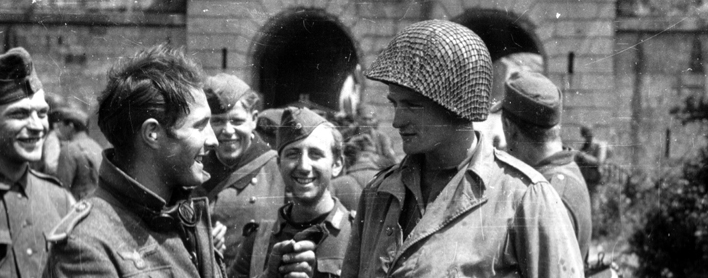
A tribute to the forgotten Victims and Veterans of WW2
WW2 was the most widespread war in history, and directly involved more than 100 million people from over 30 countries. At the end it resulted in an estimated 50 million to 85 million fatalities. These made World War II the deadliest conflict in human history.
Beeing a WW2 Military Vehicle collector is due to this fact a „heavy weight“ – we have allways to remember „the story behind“ our vehicles and have a kind of „special responsibility“ we should be aware of. Respect for the victims, the veterans and their relatives is part of that heritage as well as keeping up the memory of WW2 for generations to come – to prevent mankind from the deadly mistakes of our past.
Victims or offenders – can the question be answered after 70 years?
Among those millions of unknown victims are several members of my German part of the family: the brother of my grandfather and his son, both having been in the Wehrmacht as well as my great-grand parents. Others survived the war and kept on living after „zero hour“ as they did before the war. As my grandfather, that never talked about WW2 and his personal involvement on the „Heimatfront“. It is hard to decide today – after more than 70 years that have passed – if they have been victims or offenders, fanatic Nazis or just people „like you and I“ that wanted to survive in the times of Nazi dictatorship and WW2. As in many families in Germany nobody talked about this darkest hour in German history. All I know are some very few informations that I got from my father that passed away in 2012 and – born in 1942 – was to young to be a witness. So I tried to find out more details on my own and with the support of sources on the www, with visits of the original places, support of some archives in Germany and in the USA as well.
The unknown WW2 Veterans
In addition I started to find out more about the American veterans „on the opposite side“ that owned or used 70 years ago some of the items that I have in my WW2 collection. Many of those items remain namless and are just anonymous mass-produced artefacts. Some – few – others have the names of the previous owner or a certain site where they have been found – so that there are some traces to the soldiers and their story behind. The results of the research on those nameless veterans that returned to the USA and tried to proceed with a „normal life“ after WW2 is described below as well – as „the other side of the medal“.
To put things right: from my point of view there is no argument to „glorify“ those victims – whatever side they belonged to. There is no „glory“ in being killed in a B-17 by a German 8,8 cm Flak grenade at 10,000 feet above the ground or in beeing vaporized by a 500 lbs bomb while sitting in a basement shelter for „the Fuehrer“ and his terror regime. And in contrast to the wartime propaganda we have to learn today that thing’s 70 years ago not have been „as simple as black and white“. That’s what I found out during my research on those traces of WW2 in the past years.
During WW2 about 17 million US Soldiers have been fighting on all frontlines. Today – 2015 – are about 1 million of them still alive. Each day are about 800 of them passing away. – And with them the witnesses of WW2. Each of them with his personal story on what happened in those days between 1939 and 1945 – and after. It’s up to us to preserve the heritage of those who liberated Europe from Nazi Dictatorship for generations to come. So this is a part of my motivation in those veterans profiles listed up below. It is hard to handle figures in large scale. But you can pick up some single persons to bring those day’s back and to keep the memory of them alive.
If you have a look at the picture above you have the „essential message“ at a glance: a group of captured Wehrmacht soldiers and a young US Soldier at about the same age. The Germans are truly glad that they are still alive and the war is over for them. You can directly see the heavy weight that has fallen off from them. The American is a bit sceptical and tries to figure out what is going on – if he can trust those guy’s that 24 h. before have been his enemy – and you can see that he tries to understand what is going on in this moment.
– I think he will have understood first lateron that those former enemies have been so euphoric because they had survived the Nazi regime and a war that was not their war.
– And that’s what we should keep in mind too and should teach our children – to prevent future generations from being part of a similar insanity again, that was finally leading into that what we know today as WW2.
The Allied side of the WW2 drama…
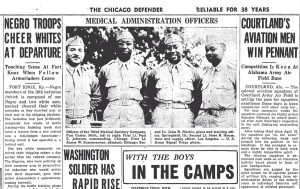
First Lt. James Summerower – an African-American U.S. Army Officer and philanthropist
Back in 2014 I bought for my militaria collection a WW2 U.S. Army garrison cap from a German collector. When it arrived I had a closer look at it and found on the inside a hand written name and a army serial number.
So – based on those informations – I started my research in the www and was surprised that this garrison cap was formerly owned by First Lt. James W. Summerower from Chicago. – One of the first Officers in the U.S. Army with African-American background.
During my research I found out that he was born in 1914 at Lake County, Indiana – so to say Southeast of Chicago and was enlisted on the 18th of February 1941 at Fort Benjamin Harrison, Indiana at the age of 27. With 4 years at the College he climbed soon up the ladder from a Private rank to a First Lieutnant and trained medical administration Officer. He served with the 703rd Medical Sanitary Company – an typical African-American support unit (a.k.a. Buffalo Soldiers) with mostly White American Officers that was based at Fort Custer, Michigan before the unit received it’s shipping orders for the embarkation to the U.K. in late 1943 or early 1944. So James Summerower was among the very first African-American Officers in the U.S. Army ever – and part of an historical turning point in the American society. Some may know the Tuskeege Airmen as the first African-American Officers in the U.S. Forces – but beside of them other African-Americans „made their way“ in the Army at this time as well, but have never been noticed by the public.
His unit was then one of only two in WW2 that have been awarded the Meritorious Unit Commendation (MUC) – for their work in loading and unloading casualties – and at least two men of the unit received the Bronze Star. (Source: Ethnic and Racial Minorities in the U. S. Military, page 703). His unit was named several times in the press – basded on pictures and informations that have been released officially by the U.S. Army Signal Corps. – Possibly written by the African-American war correspondent Ted Stanford (left) from the The Pittsburgh Courier, because Stanford was reporting directly from the European Theatre and mainly about African-American units (- as one of 27 civilian African-American war correspondents overall). So The Pittsburgh Courier, „one of the top black newspapers in the United States“ in the 1930ies and 1940ies, printed this article on Saturday June 9 1945:
MEDICAL UNIT KEPT BUSY
Combining care and painstaking spead, members of the 703rd Medical Sanitary Company at Southampton, England, unloaded more than 120,000 battle casualties between D-Day and V-E Day. During this same period they loaded more than 30,000 patients handed for the United States. The 703rd has been awarded the Meritorious Unit Service Plaque. George McPherson (left) of Brooklyn, N. Y.; Pfc. Joseph McKie (center), Clarks Hills, S. C., and Jfc. Jesse L. Meadows (right), Cleveland, Ohio, remove a patient from ambulance as First Lieut. James W. Summerower, Chicago, Ill., looks on. – U.S. Army Signal Corps Photo.
In fact was Southampton one of the most important logistic hubs for unloading and transportation of casualties from the European Theatre (ETO) in WW2. Beside of them many other African-American units as the 736th Medical Sanitary Company and many others have been on duty in the U.K. „to keep thing’s going“ at the ETO: Link to units listing. The 703rd of James Summerower was esp. from D-Day on working day and night at Southampton to it’s limits – and beyond and saved the lives of thousands of wounded soldiers that returned from the beaches in Normandy and the battlefields in the North of France during the next months.
After the victory in Europe the 703rd returned to the States and was deactivated as most of the units in the end of 1945.
James Summerower had married Fanniemae Summerower in 1941 – a schoolteacher, mathematics consultant, philanthropist and returned as most soldiers to his wife and his civilian life. He became a successful real estate broker and the couple was prominent in elite Chicago social organizations. They had no children and decided to found the The Fannimae H. And James W Summerower Educational Foundation mainly supporting kids with education scholarships.
James Summerower passed away then back in 1994 at the age of 81 and his wife then lateron in 1999.
The Chicago Tribune was stating on the 17th of September about her and her husband:
Fannimae H. Summerower
Fannimae Haughton Summerower, 86, a retired Chicago Public Schools teacher, mathematics consultant and philanthropist, died Sunday of a heart attack. Mrs. Summerower, who lived in Hyde Park for more than 50 years, taught elementary school for decades and finished her 41-year career with the Chicago schools helping teachers find better ways to teach math. „She really seemed to like that a lot,“ said her friend Genevieve Massey. After Mrs. Summerower retired, Massey said she focused her attention on philanthropic work that has provided nearly $800,000 for several universities and African-American students on their way to college. „Setting up these trusts and scholarships takes a lot of work, and she was willing to do it. She had a real commitment to education,“ Massey said. „The interest on this money is going to send a lot of kids to college.“ Mrs. Summerower set up several endowed business and education scholarships and awards at Fisk University, where she received her master’s degree in 1937. The business awards were in honor of her husband, real estate broker James Summerower, who earned his bachelor’s degree there. She also established a chair in mathematics and science at Fisk and donated two 21-unit apartment buildings to the school. She recently established the Fannimae H. and James Williams Summerower Educational Foundation with nearly $500,000 to provide scholarships for African-American students graduating from Chicago Public Schools and going on to college. She was a graduate of Northwestern University in 1936…
So it seems that the support of those who could not help themselves – on the battlefield and in the later civilian life after the WW2 – was a central theme of this outstanding couple from Chicago. Esp. the support of children with African-American background was an central theme during their whole later life – and even beyond.
– I think with more such philanthropists as this couple our world would be a better place.

Irving Smolens – The Gunner from Melrose, PA that survived D-Day at Utah Beach
Back in 2014 I organized the first WW2 Dodge Forum members Event in Normandy – together with our member Rob from the Netherlands. The name of the Event was „Dodge Gathering 2014“ – at the parking area of the Pointe du Hoc battery – with more than 70 WW2 Dodge trucks from eight different countries in place.
Our special guest at the meeting was WW2 veteran Irving Smolens: he came 70 years before on D-Day with a Dodge 3/4 ton truck to Utah Beach and was taking part in the 70 anniversary commemorations as an official guest of the French State.
He served in a artillery unit that used the Dodge for towing their howitzers. But the LST Captain was in panic because of the German defense fire and opened the ramp to early to get away as fast as possible – with the result that the water was to deep for the Dodge and killed the engine.
Irving told me, that all his personal equipment was on the Dodge and lost that way. So he was forced to fight two weeks only with the clothes he was wearing when he waded to the beach, his rifle (a 30M1 Carbine) and his ammo belt.
– Even after 70 years you could feel how angry he was about the behaviour of the LST Captain…
He was then following the frontline with his unit from Normandy to Germany and at V-Day his unit was south of Munich.
Today he is (still) visiting schools and telling the kid’s what happened 70 year’s ago to keep the memory of WW2 alive and to make them understand „that freedom is not for free“ – as he told me. So true…
I have been in contact with him lately and – sorry to say so – he think’s that his trip to Normandy 2014 was his last one…
But this trip was special – because he was sitting at the Omaha Beach War Cemetary behind the President and had the chance to talk to him. – What a great highlight for this D-Day veteran.
Irving wrote about the meeting with the President this:
„…I maneuvered to get a seat in the front row. I sat at one end of that row behind the president and slightly to his right you can see me in one of the photos. When he finished his speech he turned to his position at the other end of the row and was shaking hands with Nancy Pelosi and Secretary of State John Kerry and other dignitaries. I got up from my seat and walked across the stage to him and extended my hand to him and as we were engaging in a handshake I thanked him for keeping us out of war. I started to continue talking to him but he said. „I’ll be back“ He finished shaking the hand of every veteran sitting directly behind him. I was the last of the veterans whose hand he shook. I thanked him for the Presidential Coin he had given me about a year ago and told him that since he is Commander in Chief that I consider it a Commander’s Coin and why it is nick named a „Challenge“ Coin. Ask John King for an explanation.
Many people saw me talking to the President and wanted to know what I had said to him. When they found out I received smiles and nods of approval from all.
Enjoy
Irving“
Irving recieved in addition in October 2014 special honours from the French gouverment: he is now a „Chevalier of the French Legion of Honor“.
I have prepared a small compilation of pictures with Irving at the WW2 Dodge Forum members MV Event 2015 at Pointe du Hoc and with President Obama at the ceremony at the Omaha Beach military cemetary. See:
Irving Smolens at Pointe du Hoc
Latest update:
Irving died of acute myocardial infarction on April 11 2015 in Hebrew Rehabilitation Center in Roslindale. He was 90 and lived in Melrose, PA more than 50 years.
His last email to me in January indicated that his health was not the best because he wrote that his last years visit in Normandy would be his last one.
I am thankful that I had the chance to meet him last year at Pointe du Hoc and looking back I’m still laughing about his dry humor. I think that we have lost with Irving an outstanding person that tried since WW2 to make this world a better place.
During WW2 about 17 million US Soldiers have been fighting on all frontlines. Today – 2015 – are about 1 million of them still alive. Each day are about 800 of them passing away. – And with them the witnesses of WW2. Each of them with his personal story on what happened in those days between 1939 and 1945 – and after.
It’s up to us to preserve the heritage of those who liberated Europe from Nazi Dictatorship and those who have been fighting in the Pacific as well for upcoming generations. My recommendation: if you know veterans nearby use the chance to listen to what they have to say and write it down for generations to come.
My thoughts are with his family,
Joakim
Link to the article at the Boston Globe online from April: About Irving Smolens death in the Boston Globe
More infos about Irving at the ETO:
About his unit the 29th Field Artillery: http://www.angelfire.com/ny5/msgfisher/ww2pic-4.html
http://www.angelfire.com/ny5/msgfisher/ww2pic-4.html
About Irving Smolens in the Melrose Mirror
Irving Smolens in the online Press
Interview video at youtube:
Irving Smolens video
Review on Irvings visit at the WW2 Dodge Forum: Irving Smolens visit
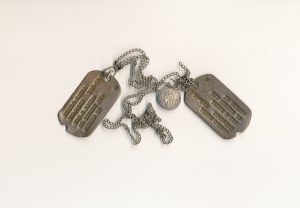
Angelo Manna – The Italo-American G.I. that liberated the city of Giessen (Germany)
I bought in early 2014 at a local Sunday flea market an US Army dog tag from WW2 with a small silver „St. Christopher“ medal. The seller was „such a typical metal detector owner“ that was selling some of his finds. To be honest: I’m „no friend“ of this sad „dog tag trading business“, because in many cases those „collectors“ make it impossible to inform the relatives of a person that is MIA (missing in action) since WW2.
So I bought that thing and back at home I started to find the „story behind“ this find so that I could inform the relatives as well as the authorities on it (in case of a person MIA). „Thank’s to google“ the answers have only been „one click away“: The owner of the dog tag was a young man with „Italian roots“ and joined the Army in 1943 as a private. He survived the WW2 and retired as a private first class. He returned to his hometown Auburn, NY and lived there as a veteran until he passed away 1976 at the age of 52.
So that’s one of the stories behind the WW2 items I have – and this one is fortunately with an happy end.
So all I can say about the background of this lost dog tag is, that Angelo Manna must have been in one of the units under General George Patton’s command that crossed the River Rhine via the legendary Remagen Bridge in the March of 1945 and proceeded to the east, heading to the Cities of Marburg and Giessen in the north of Frankfurt. It could have been the 9th Armored Division – but I’m not sure about that.
The City of Giessen is a town with a University and a population of only 80.000 in a rural area. Giessen had since 1867 a large garrison and in consequence caused that heavy fighting at the end of March 1945. The battle of Giessen was shown in the Movietone – showing the Tank battle at today’s City-Ring. With the support of Sherman Tanks the US troops could finally liberate Giessen on the 27th and 28th of March 1945.
A short video clip of the battle can be found here: Link
So I think Angelo Manna lost his Dog Tag at a Camp outside the City or in a foxhole at the frontline in the Giessen area at about those days in March – nearly 70 years ago.
About the Remagen Bridge: Ludendorff Bridge at Remagen
Photos on the 70 years commemoration at Remagen: The Bridge at Remagen 2015
Update:
Thank’s to the latest internet research I found an article published by Ormie King on 11 May, 2014 giving some details on the group of young men from Auburn that joined the Army in 1943 – among them: Angelo Manna. And the evidence that he was involved in the „Wonder at Remagen“ – the capture of the Ludendorff Bridge. The last intact River Rhine Bridge in March 1945. Link: tribute to Auburn’s WWII heroes . So here is the full story:
Today’s article was submitted to me by Jim Giannettino, and tells the incredible story of true Legends of Auburn, our young local men sent off to fight in World War II, and some upcoming events to honor them:
In late February 1943, with World War II raging, a group of about 60 young men from Auburn and the surrounding area received their draft notices in the mail. Many of those drafted were in their senior year of high school, but would have to forgo the last three and a half months of the academic year in order to report for basic training. These young men, for the most part, either knew of each other or were all friends. Many of them were neighbors on the West end of town and had grown up together.
One month later, these young men assembled at the downtown bus station and said goodbye to their families as they answered their nation’s call to service. They, along with many other contingents of draftees from New York, were assigned to the newly formed 299th Combat Engineer Battalion.
Over the next several months they underwent extensive training and relocated multiple times. Their travels took them from Fort Niagara, to Camp White, Oregon, to Fort Lewis, Washington, to Fort Pierce, Florida. Once their training was complete they were sent to New Jersey where they awaited orders to disembark for England. In April 1944, the 299th shipped out for Europe aboard the troop ship the S.S. Exchequer. After 10 days at sea they arrived in England, where they underwent additional training. In early June they were informed that they were to take part in the invasion of Normandy. The 299th was to be included in the first wave of the invasion and was tasked with clearing the beach for the second wave of the assault.
On June 6, 1944, the invasion of Normandy, code-named Operation Overload, and more commonly known as D Day, began. More than 160,000 ground troops were transported by 5,000 ships across the English Channel under the cover of darkness. Among these troops was the 299th and they were scheduled to hit the beaches at 0633. The battalion was to be split over two beaches: Company B would assault Utah beach while Companies A and C were to assault Omaha beach.
While the D-Day assault on Normandy was a success, the cost was high. More than 9,000 Allied Soldiers were killed or wounded that day, among them six men from Auburn and the surrounding area:
Claude D. Brown Jr., Nicholas V. DeAngelis, Leo A. Indelicato, Thomas J. Phillips, Lawrence A. Roberts and John R. Spinelli.
With the French coast secured more than 100,000 troops began the march across Europe to break the yoke of Nazi tyranny. The 299th was among these troops and they moved through France on to Belgium, where they fought to repel the last German offensive in the Battle of Bulge. The 299th moved on to Germany and was tasked with securing the Remagen Bridgehead. Following the German surrender on May 6, 1945, the 299th moved on to Nuremburg, where they worked to reconstruct parts of the war-damaged city. A couple of months later the unit was scheduled for demobilization and hundreds of battle-tested men, many of whom were the first to land on the beaches of Normandy, returned home. For their actions on the D-Day, the 299th Combat Engineer Battalion was awarded the Presidential Unit Citation.
Following the war, many of the Auburn boys returned home where they found jobs, and most of them got married and had families. They stayed in contact with each other after the war, not just the Auburn boys, but the entire battalion. For many years after the war they held an annual reunion that rotated from city to city. As time marched on and it became difficult for many of the men to travel, those from Auburn began to hold an annual ceremony on June 6. The first of these ceremonies occurred on June 6, 1994, the 50th Anniversary of D-Day, where the surviving members dedicated a monument to the six friends they lost on the beaches of Normandy.
I had the honor of attending a handful of these ceremonies and it was very clear that these men were friends in the true sense of the word. Being from the same town, they had gone to school together, played together, grew up together; and when they left for boot camp, they did that together, too. For many of these young men it was their first time away from home, and having their buddies with them must have made this experience more bearable. When they left they were innocent boys, but they soon became battle-hardened men. They endured the physical and mental hardships of training and combat together, and had to suffer the loss of not just fellow soldiers, but lifelong friends. There was obviously a personal connection between these men, and it was clear that the „friendship factor“ was vital in the overall success of the 299th in World War II.
June 6, 2014 will mark the 70th Anniversary of D-Day. In an effort to recognize the sacrifices of the members of the 299th and all local WWII veterans, the Cayuga Museum of History and Art will host an exhibit titled: „Auburn at Normandy: The 299th Combat Engineers and Local Stories of WWII.“ The exhibit will run from May 23 to Aug. 31 (2014) and will feature several major events to coincide with the exhibit. These events are free and open to the public and we cordially invite you to join us in saluting the Greatest Generation.
Jim Giannettino, vice president, Board of Trustees Cayuga Museum of History and Art
Link to the Museum: The Cayuga Museum
Address: The Cayuga Museum/Case Research Lab, 203 Genesee Street, Auburn, NY 13021, USA.
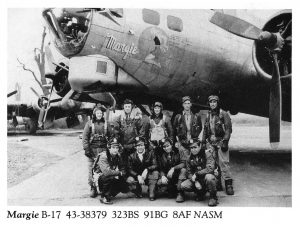
Sgt. Rheinhold Strecker – The ill-fated waistgunner of the B-17 „Jeanie“
Back in 2013 I got the offer to buy a deactivated Browning M2 Machine Gun Cal. 50. I was looking at this time for an empty housing of such a weapon as a decoration for my Dodge WC51 weapon carrier – that is equipped with an M24A1 mount for the 50 BMG. So I bought and rebuilt it and tried to find out more about it’s background. In fact it was a find from a B-17 „Flying Fortress“ crashsite that a metal detector owner had found 14 years ago near the village of Eilscheid and kept in his collection for years. Because of the position of the charging handle and the remaining bolt of the mount I think it is from the left waistgunner position of the B-17 of Captain Cecil G. McConnell.
As I could find out was his plane part of the 379th Bomb Group and on the 6th of January 1945 on a strafing mission to Colone. The mission was ill-fated from the very beginning, because the own aircraft of the McConnell crew with the name „Margie“ was out of order and the crew had to use another B-17 with the name „Jeanie“ instead. On the way back from the target the B-17 was hit by German Flak grenades. Engine no. 3 caught fire and the crew had to bail out of the plane near the village of Eilscheid. The Co-Pilot Warren T. Smith was wounded by fire and grenade parts but could bail out of the burning plane with help of the Pilot as well. After all the complete crew could escape – except of the gunner of the upper turret, George Turner.
But this 25th mission of the McConnell crew was ending in a total disaster: after the landing 3 fanatic teenagers from the „Hitlerjugend“ and an older „Volkssturm“ soldier started to fire with rifles and killed in the end two of the crew. The badly wounded Co-Pilot died the next day in a nearby field hospital. The others incl. waistgunner Rheinhold Strecker became POW. The full sad story in German – with pictures – can be found here: B-17 Bomber „Jeanie“ (#44-8501)
The informations are based on the informations given by the tailgunner Marion C. Hoffmann from Ohio in 2009 – at the age of 87.
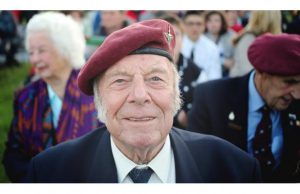
Ted Eaglen – The British Paratrooper from Pegasus Bridge
When I visited the Pegasus Bridge Museum the first time in 2013 I had the pleasure to meet Ted Eaglen there. He was standing in a group of kids and telling them what happened at the legendary bridge 69 years before.
Pegasus Bridge is a bascule bridge (a type of movable bridge), that crossed the Caen Canal, between Caen and Ouistreham, in Normandy. It was, with the nearby Ranville Bridge over the river Orne, a major objective of the British airborne troops during Operation Deadstick, part of Operation Tonga in the opening minutes of the Allied invasion of Normandy on 6 June 1944.
A unit of Glider infantry of the British 6th Airborne Division, commanded by Major John Howard, was to land, take the bridges intact and hold them until relieved. On the night of 5 June 1944, a force of 181 men, led by Major John Howard, took off from RAF Tarrant Rushton in Dorset, southern England in six Horsa gliders to capture Pegasus Bridge, and also „Horsa Bridge“, a few hundred yards to the east, over the Orne River. The force was composed of D Company (reinforced with two platoons of B Company), 2nd Battalion, Oxford and Bucks Light Infantry; 20 sappers of the Royal Engineers of 249 Field Company (Airborne); and men of the Glider Pilot Regiment. The object of this action was to prevent German armour from crossing the bridges and attacking the eastern flank of the landings at Sword Beach.
The successful taking of the bridges played an important role in limiting the effectiveness of a German counter-attack in the days and weeks following the Normandy invasion. In 1944 it was renamed Pegasus Bridge in honour of the operation. The name is derived from the shoulder emblem worn by the British airborne forces, which is the flying horse Pegasus.
Ted Eaglen survived the heavy fighting at the bridge and was wounded up to the end of WW2 several times – allways returning within short of time from the hospital to his unit. He was fighting in the Ardennes in the winter 1944/45 and was witness of the most dangerous German counter attack there during WW2 at the western front.
After WW2 Ted Eaglen returned to the civilian life in the U.K. and worked in several jobs – many years as a truck driver.
Since many years he is member of the The Royal British Legion and returning to the bridge and it’s museum to tell groups from school about what happened at this place in WW2 and to honour his comrades that did not survive.
Davy and I have been deeply impressed of this 88 years old vital gentleman and his engagement to keep up the heritage of WW2 and those who served in his unit.
About Ted Eaglen in the Press:
The Vancouver Sun
With the The Royal British Legion
His vita in brief: Military career
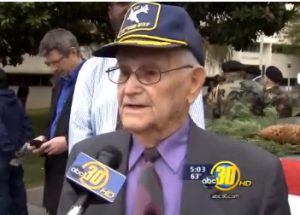
Answers given to relatives of MIA Airmen – 69 years after WW2
My latest „discovery“ and another story with a „sort of happy end“: on last Sunday I bought another B-17 part from a „bounty hunter“ (metal detector owner) for my collection. That part came from a B-17 crashsite somewhere west of the River Rhine, about 140 km north from my hometown Frankfurt. So back at home I tried to find out more about the crash and it’s background on the www and found one B-17 that came down in August 1943 nearby the town I bought the part.
The story of this B-17 F (s/n 42-5820) with the Fuselage Code: LF – C was quite dramatic: it was part of the 379 BG 526 BS and on the 12th of August 1943 on a mission to Gelsenkirchen (about 150 km north of the crash site). The target was a petro-chemical factory. But the mission was a disaster from the very beginning: „…the B-17 experienced engine trouble on route and target the no1 engine was set on fire by fighters but the brave crew continued and bombed the target. Most of the crew bailed out when the controles and another engine were lost after fighterattack.“ The B-17 crashed then in the Ahrweiler district, close to the city of Bad Neuenahr. The ball turret gunner of this plane was KIA together with another gunner. The other 7 crew members survived their Mission 18 and became POW.
The official listing of the Air Force about the crew:
Freund, Kurt W, 2nd Lt, Pilot, POW
Emens, Dale T, 2nd Lt, Co-Pilot, POW Photo
Macrae, Donald P, 2nd Lt, Nav, POW
Bozarth, Glen H, 2nd Lt, Bomb, POW
Schaedler, Francis J, TSgt, Radio Op, KIA
Ragland, James L, TSgt, Top Turret, POW
Wallace, Cyrus M, SSgt, Ball Turret, KIA
Jamison, Allan G, SSgt, Right Waist, POW
Angarano, Daniel J, SSgt, Left Waist, POW
Roberts, Charles E, SSgt, Tail, POW
While searching for details and pictures I found a post of a relative of the ball turret gunner of this plane searching for the gravesite:
„Subject: S/Sgt. Cyrus M. Wallace – B-17F s/n 42-5820
Hello,
I’m helping a friend locate any information about his great-uncle, Staff Sergeant Cyrus M. Wallace, the ball-turret gunner on B-17F, s/n 42-5820, in the 526th Bomb. Squadron. His plane went down on 8-12-43. Any info would be greatly appreciated. Thank you.
Del Mecham.“
The post was dated 2006 – 8 years old at this time – and I was not sure if I would get a reply on my e-mail with the informations I had at this time. But: 10 min. later I had a reply from the USA!
I contacted the cemetery authorities of the city of Bad Neuenahr asking for informations on the two graves – due to the fact that they have in this area 20 (!) war cemeteries from WW1 and WW2. Parallel to this I was proceeding my search on the www and got then the missing information: both victims had been buried first at a local cemetery and then been moved to the US-Military cemetery at Margraten (Netherlands). Lateron both Airman had been moved from Netherlands American Cemetery at Margraten to the Zachary Taylor National Cemetery Louisville, Jefferson County, Kentucky.
So I could inform then the relatives of the ball turret gunner Cyrus M. Wallace on that missing information.
– It’s from my point of view important for relatives to know about the fate of their relatives and to know where they now rest in piece.
Co-Pilot Dale T. Emens is today a retired Air Force Captain who spent after beeing shot down 22 months in a German war camp near the Polish border. He admits it took many years before he could even talk about it with friends of family. „Well I, at first I couldn’t talk about it at all. I lost four good men over there.“ said Emens…
See full abc TV report with Dale Emens interview: Two Valley World War II Veterans honored
Aircraft shortfacts online: B-17 42-5820
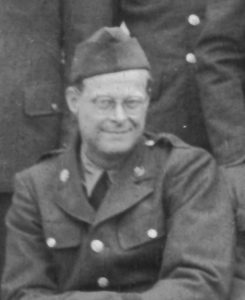
Glen E. Just – a WW2 soldiers life in a box
Many WW2 veterans returned home and tried to find their way back in to a civilian life. Uniforms and memorabilia disappeared in wardrobes or boxes – often untouched until the vetran passed away and someone found it. Sometimes in such cases the persons throw such items away – sometimes they go thru several hands and occure at eBay or local flea markets.
The Glen E. Just Collection is such a typical case: He passed away without any children or relatives, his farm was sold and under normal circumstances he would have been forgotten as so many other veterans that never gave witness of their role during WW2.
The small box that I bought via eBay in early 2015 from a trader located at Browning, Missouri contained the complete WW2 soldiers life with all informations on his military career, personal items, postcards from places in Iceland, England and Paris, a brand new XL pen from a chemical Company in Germany, parts of his Uniform, his Dog Tag etc. etc. A very rare and complete find. I have no idea at all how it ended up in Missouri?
The Glen Just Collection at a glance incl. photos of What Cheer, Iowa – hometown of Glen Just can be found here:
The Glen Just WW2 Collection
The Army file in the box stated that Mr. Just was with the 92nd Replacement Battalion during World War II in Europe and served as an Technician Third Grade (T/3 – often addressed as Staff Sergeant) as his shoulder insignia indicate. The listed battles have been:
Normandy, Northern France, Ardennes, Rhineland and Central Europe.
Glen Just was awarded with the Good Conduct Medal, six overseas service bars and the Silver Battle Star.
It was hard to find more details on his unit and up to now I found only this brief hint:
„…the 92nd Replacement Battalion saw heavy service across Europe, moving with Allied forces during some of the toughest fighting of the war: Normandy, the Rhineland, and the Ardennes Forest. The after-action review on the battle of the Hürtgen Forest (south of the City of Aachen, Germany) showed the historic, key role this battalion has played in the nations defense…“
The other hint was the info that the unit was involved in the heavy battle at Carentan, Normandy as well.
So a 28 years old Farmer (with a mother by the family name Ewald = with German roots) from What Cheer, Iowa joined the US-Army on Jan. the 28th 1942 at Fort Des Moines, Iowa and made it via the Quartermaster Replacement Training Center at „The Second Camp Lee“, VA then to Iceland, the U.K. further to Normandy and the Ardennes and liberated Europe from the Nazi terror…
There is no information on how far he came, but the German pen indicates that he was somewhere in Germany at the end of WW2 in Europe.
– 3 years, 6 months and 20 days with the Army after all.
After his honorable discharge as a warrant officer on the 18th of August 1945 at Fort Sheridan, Illinois he returned to his hometown What Cheer and passed away at the age of 82 in 1996. His brother and sister (?) passed away only some years later and it seems that he has no living closer relatives today.
Due to the fact that this was in the „age before the internet revolution“ I could not find any pictures of him in his later life or informations on his civilian career. So I was „stuck“ with my research and Mr. Just as a person is still „reduced to a pile of figures“.
So some of the items I found in the box are „indicators“ for the „private Mr. Just“: a picture of a white cat on his yard, dated 1942 and the name of the cat: „Fluff“ that is written on the back of the photo. In the background you can see two more cats as well. Another photo is showing one more cat and a dog by the name „Mike“. Then a picture of a corn picker and a tractor on his yard (the corn picker could be made by New Holland and the tractor could be a John Deere). – I guess he was taking the photo when the Just family bought it in November 1942. Not a big surprise because he was a farmer – with a heart for cats.
Another item: a small arctic flower glued to a sheet of paper that he collected at Iceland, in addition to an small Iceland Flag, four photos from Iceland (no postcards!) – all with a stamp on the back of the censor of the Iceland Base Command (IBC). The very rare IBC uniform patch of it in Glen Just’s collection indicates that he was there for a while. A farmer from Iowa in the Arctic summer. He must been deeply impressed by the wild nature and steep mountains.
– So much, that he kept this small pressed flower thru the years and WW2 and brought it back home. Seeing this small fragile flower is touching my heart. I think Glen Just was a sensitive person, with an eye for the small things around us.
I could not find any details on his path across Europe during WW2. But some commercial postcards – maybe bought as a set – from the south coast of England must have been bought close to his port of embarkation to Normandy. I could find a similar set of postcards from Paris. – His next station after D-Day and the heavy battle in the North of France.
If he was involved in the battle at the Hürtgenwald Forrest (north of the Ardennes) he was involved in the hardest battle of the US Army in WW2. The losses there have been higher than the overall loss of soldiers in the complete Vietnam war. The US Army needed several months to clear the area from German Forces. But the only evidence, that Glen Just was in Germany is this pen from the Chemische Fabrik Grünau (close to Berlin) and his service record.
Another „untold story“ is the Silver Battle Star of Glen Just. There is no background information about it except of the Army file. The insignia as well as the Medal of Good Conduct and the overseas service bars are missing. I think they have been in the box as well – but been sold seperately by a previous owner (dealer).
A small booklet published by the Army is indicating that he returned via Camp Kilmer, NJ in about July or early August 1945 to the USA. From there he was sent to the separation center at Fort Sheridan, Illinois.
– On the 18th of August 1945 ended WW2 for Glen E. Just at Fort Sheridan, Illinois.
And this is the end of the story, that this small box is telling us. It seems that Glen Just recieved a final payment of USD 100,- at Fort Sheridan and returned by train home to What Cheer and putted all those items he collected from 1942 on together in this box, closed the lid of it and kept it in a hidden corner of his farm until he passed away. I think he kept his uniform too, but I guess the uniform was dumped lateron because of clothes moths. His Garrison Cap is indicating this because you can see several holes from the moths.
So my research ended with the documents in the box in the year 1945 and the www research was only stating the date when he passed away. So I contacted Bill Miller from the Library at What Cheer and tried to find out more about Glen Just and his life after he returned home. Bill was very surprised to get an e-mail from a collector in Germany, but I was lucky – he was old enough to remember Glen Just and to tell me a bit what he knewed about him:
„No, I did not expect an e-mail from Germany and what a pleasant surprise. I am semi-retired and the Director of our small local library. It happens that I knew Glen Just. I grew up on a farm about a mile from his home. He died a farmer and as I remember was known for his mechanical skills. I remember him and his brother Alvin exchanging work with my father once in a while. I also remember him coming to What Cheer to play cards in the local pool hall. His farm and his brothers farm were sold after their deaths.
Glen never married and had no children and left his farm to his niece and nephew who later sold it. As far as I know they are still alive but know nothing about their whereabouts. All of the structures on both farms that were in place at that time are now gone.“
That Glen Just was a good mechanic was no surprise to me. He must have had practise from the machines on the farm – so the Army decided to give him a special training as a automotive mechanic and he ended up in a unit of the Army Service Forces, as his shoulder patch in the box indicates. But there is no evidence if he was working at the European Theatre behind the frontline as an automotive mechanic or if he has really has been under enemy fire.
There are only three photos showing him: One with him and a young girl sitting smiling on a bench at Williamsburg on the 5th of April 1942, one showing him on a picture with the complete Company „B“ 10th QM Training Regiment at Camp Lee, VA before embarkation to Iceland and a last one is showing him at the ETO. I have the impression, that he looks much older on this photo with hard lines in his face. Looking again and again at this photo I have the impression that something has happened in between, that the pictures and documents don’t tell us.
It is this picture that he choosed after the end of WW2 for the Service Record of his hometown – a sort of high school yearbook from about 1948 (?) with all WW2 veterans from What Cheer – sponsored by the American Legion No. 533 and What Cheer and community business men. So this is the latest document in the collection – a WW2 soldiers life in a box.
Hopefully this time capsule will tell future generations more about farmers like Glen Just that did their job in WW2 – liberated Europe from Nazi dictatorship – and made this world a better place. Veteran Glen Just is gone – but this way he is not forgotten.
This research is dedicated to the children of What Cheer, Iowa to help them to learn from the past.
Additional information sources:
wikipedia offers an own page on What Cheer: http://en.wikipedia.org/wiki/What_Cheer,_Iowa
The What Cheer Opera House is one of the „jewels“ among the few old buildings in town and has been rebuilt some years ago. It’s inside very interesting. See: https://trundlebedtales.wordpress.com/2008/06/30/what-cheer-opera-house/
Some more nice photos from this „fading beauty“ can be found on the site „Forgotton Iowa“:
http://forgotteniowa.com/post/114267640950/what-cheer-iowa-population-646-robert-forsyth?route=/post/:id/:summary
At youtube is a nice video on driving thru What Cheer – giving a good impression of the village today:
https://www.youtube.com/watch?v=3BXVG1PcxTA
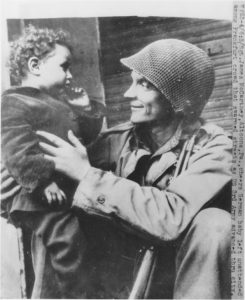
S/Sgt. James E. „Jim“ McCartney – the forgotten „brave Liberator“ of Frankfurt
29.03.1945: On Thursday the 29th of March 1945 (the so called German „Gründonnerstag“) the official capitulation of the city of Frankfurt am Main is proclaimed via the American Forces Radio Luxemburg. Frankfurt is after a 3 days battle not any longer a so called Frontstadt and officialy liberated by the US-Forces. – „Zero hour“ in Frankfurt is about six weeks before WW2 officialy ends in Germany.
The News of the Liberation of the City of Frankfurt was spread soon by the international Press and Signal Corps war corrospondents sended some pictures of the capturing of the strategic important Wilhelmbrücke via wire photo’s around the globe. Another major City of the „Reich“ had been Liberated by Patton’s 3rd Armored Division that was now heading to the east and north.
On one of the dramatic days a Signal Corps photographer made some „iconic“ pictures. One is showing US troops at the Baseler Platz heading for the central railway station. The other one is a direct contrast to it: showing S/Sgt. James McCartney from Altoona, Pa. with a German child and his Garand rifle. It might have been a real situation or a sort of „posing“ for propaganda purposes. I guess we will never know.
Anyhow – the symbolic character of the photo is still today impressive – showing the brave G.I. and what I would call „an glimpse of hope“ in this insane war.
As I could then lateron find out was James „Jim“ McCartney at this time 29 years old. He was born on Nov. 5, 1915 at Altoona, Blair County Pennsylvania as the son of William D. and Mary (Meredith) McCartney. He married Mary C. Sager on Dec. 23, 1943, in Winchester, VA. – and I would say this was just before the embarkation of his unit to the U.K.
He served in Patton’s Third Army and was taking part at the Battle of the Bulge, before he crossed the River Rhine and liberated Frankfurt. For his duty he received the Silver Star and Purple Heart medals.
– But as for so many WW2 was not the last war for him: so he served lateron as a sharpshooter in the Korean conflict.
Back from Korea he returned to his civilian life as a welder. McCartney retired from Penn. Central Railroad then in 1970, after 36 years of service.
On Dec. 23, 1994 he died in the early morning, at Altoona Hospital, following an extended illness at the age of 79. Surviving are at this time his wife, four daughters: Corinda Finochio of Altoona, JaNean Karlie of Riggles Gap, Kathleen Aikens of Greenwood and Denise Wolfe of Bellwood; two sons; William D. of Bellwood and David J. of Pinecroft; 17 grandchildren and 11 great grand-children. He was buried then at Logan Valley Cemetery, Bellwood.
The dramatic liberation of the City of Frankfurt in March 1945 had started on March 26 – only some days before the photo of James „Jim“ McCartney was taken and then published in the first week of April 1945. The battle at the „Frontstadt Frankfurt“ ended quickly after 3 days and two lucky coincidences: the capture of the damaged Wilhelmbrücke (today: Friedensbrücke) that German Wehrmacht pioneers could not blow up completely – and an US howitzer grenade that killed the most commanding German officers in their HQ in the center of the City – with the result that any organized defense collapsed within the next hours after that.
The full story of the Liberation of Frankfurt can be found here as an pdf file based on my research:
TIMETABLE OF THE LIBERATION OF FRANKFURT.pdf.
Some photos on the Liberation of Frankfurt – partwise taken from a German Spiegel-TV documentary with US National Archive material – can be found here: http://www.steel-toys.com/FL45/.
NEXT PART STILL UNDER CONSTRUCTION!
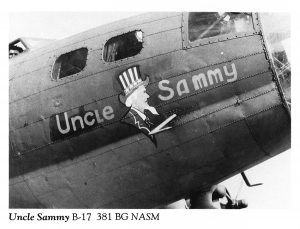
The crew of the lost B-17 „Uncle Sammy“
SAMPLE TEXT….
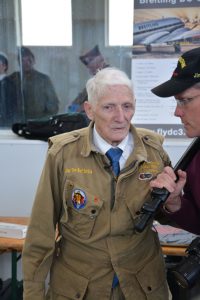
„Pee Wee“ Martin 101 AB – still skydiving after 70 years
SAMPLE TEXT…. Link: Pee Wee Martin
Latest update: 30.08.2017